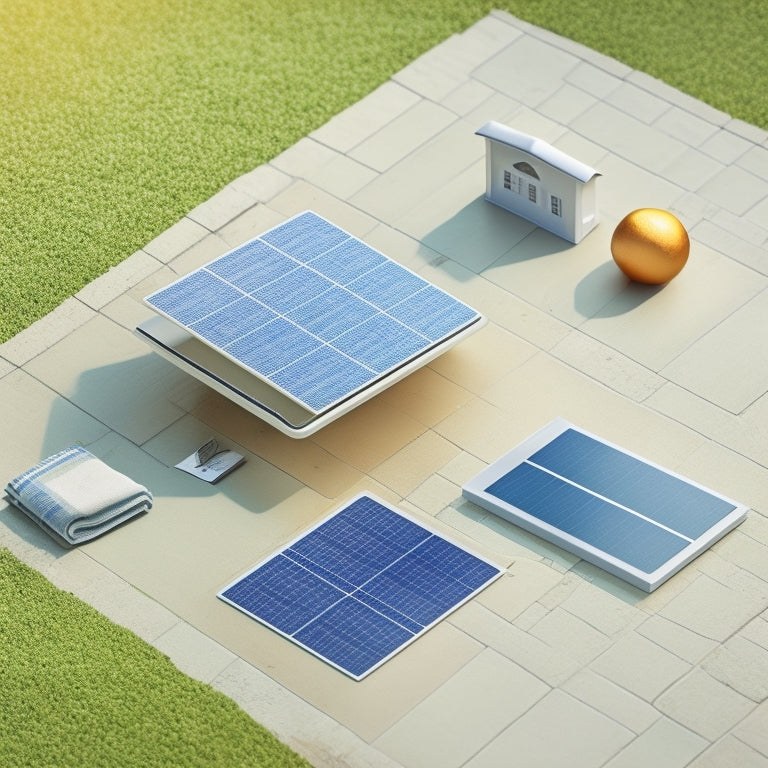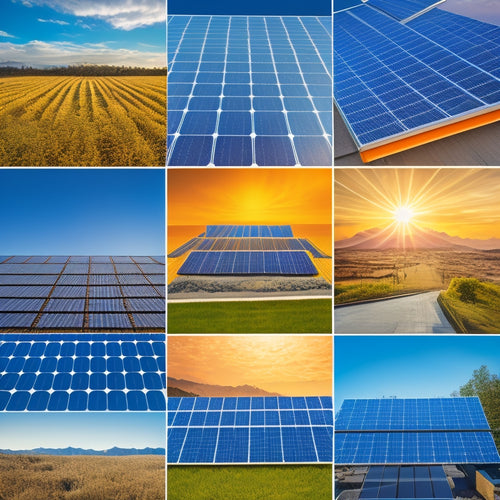
What to Know About Solar Panel Cost Per Panel
Share
When considering solar panels, you'll likely pay between $2.50 and $3.50 per watt, depending on the type, size, and quality of the panel, as well as installation costs and local incentives. The cost per panel is influenced by factors like panel materials, market trends, installation location, warranties, and financing options. High-efficiency panels, for instance, are generally more expensive but yield more power. To get the best value, you'll want to research and compare prices from various manufacturers. As you investigate your solar options, you'll find there's more to uncover about the factors driving cost and how to make the most of your investment.
Key Takeaways
- The cost per solar panel is influenced by factors like type, size, wattage, and market trends, with high-efficiency panels generally being more expensive.
- The average cost of solar panels ranges from $2.50 to $3.50 per watt, with larger systems providing more power but at a higher cost.
- High-efficiency panels can generate up to 25% more energy than standard panels, but at a higher initial cost, which can lead to long-term savings.
- Budget-friendly solar options like low-cost panel brands and community solar programs can help reduce installation costs without sacrificing efficiency.
- Government incentives, tax credits, and rebates can significantly lower the overall cost of solar panels, making them a more accessible option.
Understanding Solar Panel Pricing
When considering solar panel installation, one of the most critical factors to evaluate is the cost per panel. You're likely wondering what drives the pricing of these panels, and whether it's worth the investment.
The cost per panel is heavily influenced by the type of solar panel materials used. For instance, high-efficiency panels made from premium materials like monocrystalline silicon tend to be more expensive than their polycrystalline counterparts. In addition, the size and wattage of the panel also impact the cost.
Market trends also play a significant role in shaping solar panel pricing. As demand for renewable energy solutions increases, manufacturers are scaling up production to meet the need. This increased supply has led to a decrease in costs, making solar panels more affordable for consumers.
Moreover, government incentives and tax credits can also impact the final cost of solar panel installation. By understanding these factors, you can make an informed decision about whether solar panels are right for you.
Factors Affecting Cost Per Panel
A complex interplay of factors determines the cost per solar panel, and understanding these influences is vital for making informed decisions about your investment.
As you weigh your options, consider the impact of panel materials, which can greatly affect the overall cost. For instance, high-efficiency panels made from premium materials will generally cost more than standard panels. Market trends also play a role, with prices fluctuating based on supply and demand.
Your installation location is another key factor, as local labor costs, permits, and regulations can vary greatly.
Panel warranties, which typically range from 25 to 30 years, can also influence the cost per panel. Additionally, financing options, such as loans or leases, can affect the upfront cost.
As you pursue energy independence, remember that lower maintenance costs and a reduced environmental impact can provide long-term savings and benefits.
Average Cost of Solar Panels
You're likely wondering what the average cost of solar panels is, considering the factors that affect cost per panel.
The answer largely depends on the system size, which directly impacts the overall cost.
On average, you can expect to pay around $2.50 to $3.50 per watt, but this price can vary considerably depending on the size of your system.
System Size Matters
System size plays an essential role in determining the average cost of solar panels. When you're weighing the option of installing solar panels, you need to reflect on your energy needs and system capacity. A larger system will naturally cost more, but it'll also provide more power.
Here are some key factors to evaluate when assessing system size:
-
Energy needs: How much power do you need to generate to meet your energy requirements?
-
Panel types: Different panel types have varying levels of efficiency, which affects system size and cost.
-
Installation location: The amount of sunlight your location receives will impact the system size you need.
- Warranty options: Larger systems often come with longer warranties, which can impact overall cost.
Additionally, you'll want to reflect on factors like performance degradation, financing options, maintenance costs, environmental impact, and grid connection when determining the ideal system size for your needs.
Price Per Watt
By the time you've determined your ideal system size, it's essential to understand the average cost of solar panels, which is typically measured by the price per watt. This metric indicates the cost of a single watt of power generated by a solar panel. The industry standard for residential solar panels ranges from $2.50 to $3.50 per watt.
When evaluating the price per watt, consider the solar panel efficiency, which affects the overall cost. Higher-efficiency panels typically come with a higher price tag but generate more power per unit area. However, they may not always be the best value, as lower-efficiency panels can still provide sufficient power at a lower cost.
Manufacturing processes also influence the price per watt. Advanced manufacturing techniques and economies of scale can drive down costs, making solar panels more affordable.
Be sure to research and compare prices from different manufacturers to find the best value for your investment.
High-Efficiency Panel Costs
Across the solar panel market, high-efficiency panels have emerged as a premium option for homeowners and businesses seeking to maximize their energy output.
These high-performance panels boast higher power ratings, typically above 300 watts, and are designed to provide more electricity per hour of sunlight.
You'll benefit from high-efficiency panels in several ways:
-
Increased energy production: High-efficiency panels can generate up to 25% more energy per hour than standard panels, making them ideal for small or shaded roofs.
-
Longer panel lifespan: High-efficiency panels are built with more durable materials, extending their lifespan to 30 years or more, compared to 20-25 years for standard panels.
-
Space efficiency: With higher power ratings, you'll need fewer high-efficiency panels to achieve the same energy output, saving roof space and installation costs.
- Improved warranty options: Manufacturers often offer extended warranties for high-efficiency panels, providing added peace of mind for your investment.
While high-efficiency panels come at a higher upfront cost, their benefits can lead to significant long-term savings and increased energy independence.
Budget-Friendly Solar Options
You're likely looking for ways to reduce your upfront solar panel costs without sacrificing performance.
Low-cost panel brands like Trina and Jinko offer affordable options without compromising on efficiency.
Additionally, discounted installation options, such as community solar programs or group purchasing, can also help you save on your overall solar setup.
Low-Cost Panel Brands
Your wallet doesn't have to take a hit to go green. Affordable options are available in the solar panel market, and brand comparisons can help you find the best fit for your budget.
When it comes to low-cost panel brands, you're not sacrificing quality for cost. These brands offer reliable and efficient solar panels at a lower price point.
Here are some budget-friendly solar panel brands to evaluate:
-
Trina Solar: Known for their high-efficiency panels, Trina Solar offers affordable options without compromising on quality.
-
Hanwha Q CELLS: This brand offers a range of solar panels with high efficiency ratings and competitive pricing.
-
Jinko Solar: Jinko Solar is a popular choice for those on a budget, offering reliable and efficient solar panels at an affordable price.
- LONGi Solar: LONGi Solar is a leading manufacturer of solar panels, offering high-quality and affordable options for homeowners and businesses.
These brands offer a range of affordable options, making it easier for you to shift to solar energy without breaking the bank.
Discounted Installation Options
By the time you've selected your solar panels, you're likely enthusiastic to get them installed and start generating clean energy. However, installation costs can be a significant burden.
Fortunately, there are discounted installation options available to make your shift to solar power more affordable.
One way to reduce installation costs is by exploring financing options. Many solar panel manufacturers and installation companies offer financing plans with low or no down payments. These plans can help you spread the cost of installation over several years, making it more manageable.
Additionally, some states and utilities offer rebates and incentives for switching to solar power, which can further reduce your upfront costs.
Another way to save is by looking for installation discounts. Some companies offer discounts for bulk installations, referrals, or bundled services.
You can also consider grouping together with neighbors or friends to negotiate a discounted group rate. Be sure to research and compare prices from different installers to find the best deal for your budget.
Cost Per Watt of Solar Panels
Within the solar panel market, an essential factor in determining the overall cost of a system is the cost per watt of solar panels. This metric helps you understand the value you're getting for your money.
When evaluating solar panels, you'll notice that more efficient panels typically cost more per watt. However, they can also provide more power in a smaller space, which may be beneficial for your specific installation.
When considering the cost per watt, keep the following factors in mind:
-
Solar panel efficiency: More efficient panels produce more power per unit area, but are often more expensive.
-
Installation financing: The cost per watt can impact your financing options and overall return on investment.
-
Panel quality and durability: Higher-quality panels may cost more per watt, but can last longer and perform better over time.
- System design and configuration: The cost per watt can vary depending on the specific design and configuration of your solar panel system.
Installation Costs and Labor
As you weigh the cost per watt of solar panels, it's equally important to reflect on the installation costs and labor involved in bringing your system online. The installation costs encompass a range of expenses, including the type of installation, site preparation, and equipment costs.
There are several installation types to evaluate, including rooftop, ground-mounted, and tracking systems, each with its own unique requirements and costs.
Labor rates also play a significant role in the overall installation cost. The cost of hiring a professional installer can vary depending on factors such as location, experience, and certifications.
On average, labor rates range from $2 to $5 per watt, which can add up quickly depending on the size of your system. Additionally, the complexity of the installation, such as the need for specialized equipment or permits, can also impact labor costs.
It's crucial to research and compare quotes from different installers to find the best balance of quality and cost for your solar panel system.
Incentives and Rebate Programs
While you're calculating the cost per watt of solar panels, you should also factor in the financial benefits that incentives and rebate programs can provide.
These programs can greatly reduce the upfront cost of solar panel installation, making it more affordable for you.
-
Federal Incentives: The federal government offers tax credits of up to 26% of the total installation cost. This can be claimed on your tax return, providing a considerable reduction in your tax liability.
-
State Rebates: Many states offer rebates for solar panel installations, which can range from a few hundred to several thousand dollars.
-
Local Programs: Local governments and utilities often provide additional incentives, such as installation grants or low-interest financing options.
- Tax Credits and Financing Options: Some states and local governments offer tax credits or financing options that can help you save money on your solar panel installation.
Long-Term Savings and ROI
Numerous homeowners who invest in solar panels reap significant long-term savings and a substantial return on investment (ROI).
You'll benefit from reduced electricity bills and potentially increase your property value. A typical residential solar panel system can save you between $400 and $1,000 per year on electricity costs. Over the system's 25-year lifespan, that's a total savings of $10,000 to $25,000.
When evaluating the investment potential of solar panels, a financial analysis is essential. You'll want to reflect on factors like the system's upfront cost, local incentives, and your current electricity rates.
With solar panels, you'll generate free energy and reduce your reliance on the grid. As electricity rates rise, your savings will increase, providing a hedge against inflation.
A thorough financial analysis will help you understand the ROI of your solar panel investment and make an informed decision about whether it's right for you. By crunching the numbers, you'll see that solar panels offer a persuasive investment opportunity with long-term savings and a substantial ROI.
Frequently Asked Questions
Can I Mix and Match Solar Panels From Different Manufacturers?
You can mix and match solar panels from different manufacturers, but be aware that panel compatibility and efficiency differences might impact your system's overall performance, so make certain the panels you choose are compatible and optimized for maximum energy output.
Do Solar Panels Work During Power Outages or Blackouts?
When you invest in solar panels, you won't have power during outages unless you pair them with battery storage, achieving grid independence. This combo allows you to capture and store energy, ensuring you're powered up even when the grid goes down.
Can I Install Solar Panels Myself to Save on Labor Costs?
If you're considering a DIY installation to save on labor costs, you'll need to weigh the risks: without proper training, you may compromise your system's efficiency and safety, and even void your warranty, so it's essential to carefully weigh the pros and cons before deciding.
Are There Any Solar Panel Warranties That Cover More Than 25 Years?
You'll find that some top manufacturers offer extended warranties with warranty coverage up to 30 years or more, providing you with long-term protection and peace of mind for your solar panel investment.
Do Solar Panels Increase the Value of My Property?
As you utilize the sun's energy, your property's value shines brighter too! You'll reap the benefits of increased property appraisal and long-term energy savings, making your investment a smart move that powers your future.
Conclusion
As you weigh the pros and cons of going solar, remember that the cost per panel is just one piece of the puzzle. On one hand, high-efficiency panels may break the bank upfront, but they'll pay off in the long run. On the other hand, budget-friendly options might be more affordable, but they may not yield the same returns. By considering all the factors, from installation costs to incentives, you can strike a balance between upfront costs and long-term savings, and reap the benefits of solar energy.
Related Posts
-

How Solar Panels Increase Property Value
Installing solar panels considerably increases your property value by improving energy efficiency and attracting eco-...
-

Innovative Sustainable Materials for Energy-Efficient Homes
Innovative sustainable materials enable you to create energy-efficient homes while promoting environmental responsibi...
-

Comparative Analysis of Top Solar Brands
To conduct a comparative analysis of top solar brands, focus on key metrics like durability, energy efficiency, and s...


